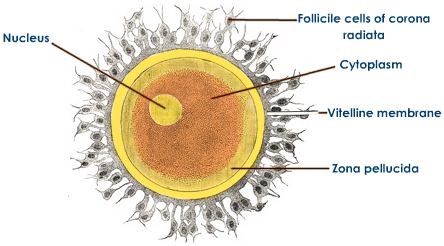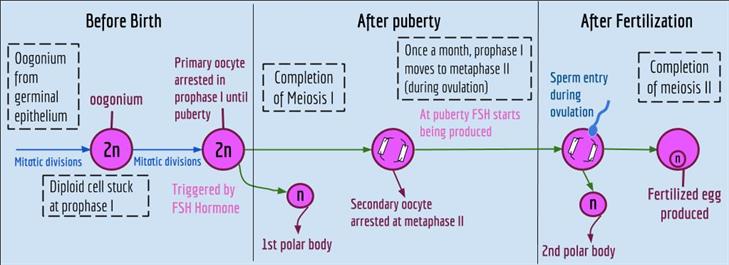
PUMPA - SMART LEARNING
எங்கள் ஆசிரியர்களுடன் 1-ஆன்-1 ஆலோசனை நேரத்தைப் பெறுங்கள். டாப்பர் ஆவதற்கு நாங்கள் பயிற்சி அளிப்போம்
Book Free DemoOvum is a female gamete that is produced in the ovaries of the female.
The process of formation of a mature ovum in the ovaries is known as oogenesis.
The mature ovum or an egg is spherical in shape. The ovum is essentially yolk-free. It has abundant cytoplasm called ooplasm and a large nucleus. The nucleus contains a prominent nucleolus.
The plasma membrane surrounds the cytoplasm. Small vesicles called cortical granules are found under the plasma membrane. The ovum is surrounded by three membranes, namely:
1. Zona pellucida
2. Corona radiata
3. Vitelline membrane

Structure of the ovum
The plasma membrane is surrounded by an inner thin zona pellucida and an outer thick corona radiata. Zona pellucida is acellular. The corona radiata is formed of the follicular cells.
The membrane forming the surface layer of the ovum is called the vitelline membrane. The fluid-filled space between the zona pellucida and the surface of the egg is called perivitelline space.
The following video shows the structure of the ovum:
In contrast to males, in females, the initial steps occur prior to their birth. Diploidoogonia and primary oocytes are produced in the foetus when a girl is born.
In oocytes, the first meiotic division is initiated and then stopped. No further development occurs until the girl becomes sexually mature. After maturity, the primary oocytes resume their development. The primary oocytes grow further and complete meiosis I, forming a large secondary oocyte and a small polar body.
Only after fertilisation, meiosis II is completed. By the completion of meiosis II, secondary oocytes get converted into a fertilised egg or zygote.

The process of oogenesis
Reference:
https://humanreproduction11.wordpress.com/fertilization/
https://upload.wikimedia.org/wikipedia/commons/c/cc/Biology_Wiki_Diagram_--_oogensis.jpg